Roxatidine attenuates mast cell-mediated allergic inflammation via inhibition of NF-κB and p38 MAPK activation
- PMID: 28139747
- PMCID: PMC5282503
- DOI: 10.1038/srep41721
Roxatidine attenuates mast cell-mediated allergic inflammation via inhibition of NF-κB and p38 MAPK activation
Abstract
Roxatidine is an active metabolite of roxatidine acetate hydrochloride which is a histamine H2-receptor antagonist that is used to treat gastric and duodenal ulcers. In this study, we investigated the anti-allergic inflammatory effects and the underlying molecular mechanism of roxatidine in phorbol 12-myristate 13-acetate and calcium ionophore (PMACI)-stimulated human mast cells-1 (HMC-1), compound 48/80-induced anaphylactic animal model and chemical allergen-induced contact hypersensitivity (CHS) models. Roxatidine suppressed the mRNA and protein expression of inflammatory cytokines such as TNF-α, IL-6, and IL-1β in PMACI-stimulated HMC-1 and compound 48/80-induced anaphylactic mice. In addition, roxatidine attenuated PMACI-induced nuclear translocation of NF-κB and the phosphorylation of MKK3/6 and MK2, which are both involved in the p38 MAPK pathway. Furthermore, we observed that roxatidine suppressed the activation of caspase-1, an IL-1β converting enzyme, in PMACI-stimulated HMC-1 and compound 48/80-induced anaphylactic mice. In CHS model, roxatidine significantly reduced ear swelling, increased number of mast cells, production levels of cytokines and migration of dendritic cells. Our findings provide evidence that the anti-allergic inflammatory properties of roxatidine are mediated by the inhibition of NF-κB and caspase-1 activation, p38 MAPK pathway and mast cell-derived cytokine production. Taken together, the in vitro and in vivo anti-allergic inflammatory effects suggest a possible therapeutic application of roxatidine in allergic inflammatory diseases.
Conflict of interest statement
The authors declare no competing financial interests.
Figures
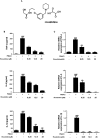
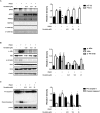
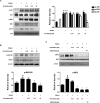
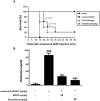
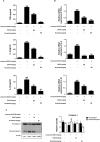
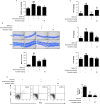
Similar articles
-
Roxatidine suppresses inflammatory responses via inhibition of NF-κB and p38 MAPK activation in LPS-induced RAW 264.7 macrophages.J Cell Biochem. 2011 Dec;112(12):3648-59. doi: 10.1002/jcb.23294. J Cell Biochem. 2011. PMID: 21809375
-
Vigna angularis inhibits mast cell-mediated allergic inflammation.Int J Mol Med. 2013 Sep;32(3):736-42. doi: 10.3892/ijmm.2013.1430. Epub 2013 Jul 4. Int J Mol Med. 2013. PMID: 23828310
-
The Inhibitory Effect of Nodakenin on Mast-Cell-Mediated Allergic Inflammation Via Downregulation of NF-κB and Caspase-1 Activation.J Cell Biochem. 2017 Nov;118(11):3993-4001. doi: 10.1002/jcb.26055. Epub 2017 May 30. J Cell Biochem. 2017. PMID: 28407357
-
Mast cells in allergic and inflammatory diseases.Curr Pharm Des. 2012;18(16):2261-77. doi: 10.2174/138161212800165997. Curr Pharm Des. 2012. PMID: 22390690 Review.
-
The role of inflammation and allergy in acute coronary syndromes.Inflamm Allergy Drug Targets. 2008 Sep;7(3):136-44. doi: 10.2174/187152808785748128. Inflamm Allergy Drug Targets. 2008. PMID: 18782020 Review.
Cited by
-
Effects of Angelica gigas Nakai as an Anti-Inflammatory Agent in In Vitro and In Vivo Atopic Dermatitis Models.Evid Based Complement Alternat Med. 2018 Mar 11;2018:2450712. doi: 10.1155/2018/2450712. eCollection 2018. Evid Based Complement Alternat Med. 2018. PMID: 29713361 Free PMC article.
-
Aurora kinase inhibitor tozasertib suppresses mast cell activation in vitro and in vivo.Br J Pharmacol. 2020 Jun;177(12):2848-2859. doi: 10.1111/bph.15012. Epub 2020 Apr 6. Br J Pharmacol. 2020. PMID: 32017040 Free PMC article.
-
The Antioxidant and Anti-Inflammatory Properties of Bee Pollen from Acorn (Quercus acutissima Carr.) and Darae (Actinidia arguta).Antioxidants (Basel). 2024 Aug 13;13(8):981. doi: 10.3390/antiox13080981. Antioxidants (Basel). 2024. PMID: 39199227 Free PMC article.
-
Roxatidine inhibits fibrosis by inhibiting NF‑κB and MAPK signaling in macrophages sensing breast implant surface materials.Mol Med Rep. 2020 Jan;21(1):161-172. doi: 10.3892/mmr.2019.10815. Epub 2019 Nov 12. Mol Med Rep. 2020. PMID: 31746427 Free PMC article.
-
H2-antagonist in IgE-mediated type I hypersensitivity reactions: what literature says so far?Clin Mol Allergy. 2021 Apr 13;19(1):4. doi: 10.1186/s12948-021-00143-y. Clin Mol Allergy. 2021. PMID: 33849573 Free PMC article.
References
-
- Kemp S. F. & Lockey R. F. Anaphylaxis: a review of causes and mechanisms. J Allergy Clin Immunol 110, 341–348 (2002). - PubMed
-
- Kim S. H. et al.. Gallic acid inhibits histamine release and pro-inflammatory cytokine production in mast cells. Toxicological sciences: an official journal of the Society of Toxicology 91, 123–131 (2006). - PubMed
-
- Baud V. & Karin M. Signal transduction by tumor necrosis factor and its relatives. Trends Cell Biol 11, 372–377 (2001). - PubMed
-
- Baeuerle P. A. & Baltimore D. I kappa B: a specific inhibitor of the NF-kappa B transcription factor. Science 242, 540–546 (1988). - PubMed
Publication types
MeSH terms
Substances
LinkOut - more resources
Full Text Sources
Other Literature Sources
Medical
Miscellaneous

